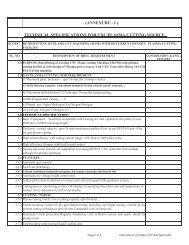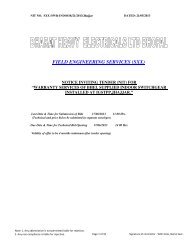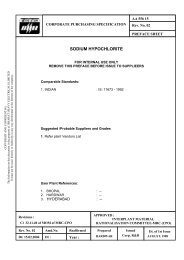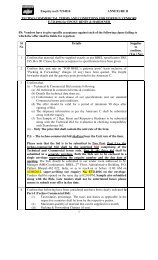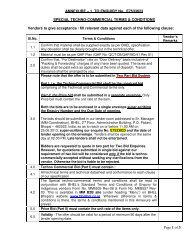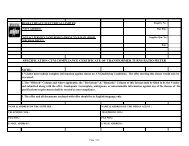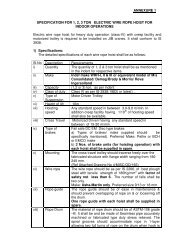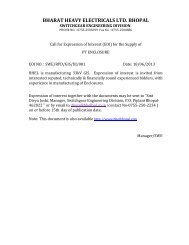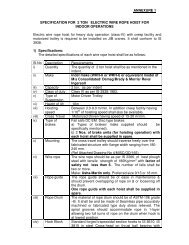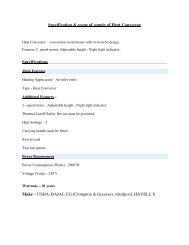AA21101 - BHEL Bhopal
AA21101 - BHEL Bhopal
AA21101 - BHEL Bhopal
You also want an ePaper? Increase the reach of your titles
YUMPU automatically turns print PDFs into web optimized ePapers that Google loves.
AA 211 01<br />
CORPORATE PURCHASING SPECIFICATION<br />
Rev. No. 03<br />
PREFACE SHEET<br />
PRESSBOARD MOULDING<br />
FOR INTERNAL USE ONLY<br />
REMOVE THIS PREFACE BEFORE ISSUE TO SUPPLIERS<br />
COPYRIGHT AND CONFIDENTIAL<br />
The Information on this document is the property of BHARAT HEAVY ELECTRICALS LIMITED<br />
It must not be used directly or Indirectly in any way detrimental to the Interest of the company.<br />
Comparable Standards:<br />
Suggested/Probable suppliers and grades:<br />
1. H.Weidmann Ltd. Switzerland.<br />
2. Pucaro Electroisolierstoffe Gmbh Germany<br />
3. Figeholms Bruk Sweden<br />
4. Raman Boards Ltd, Mysore<br />
User Plant References:<br />
1. BHOPAL : BP 21194<br />
2. JHANSI : BP 21194<br />
Revisions :<br />
Cl: 33.3.3 of MOM of MRC-E<br />
APPROVED :<br />
INTERPLANT MATERIAL<br />
RATIONALISATION COMMITTEE -MRC (E)<br />
Rev. No. 03 Amd.No. Reaffirmed<br />
Dt: 01.10.2003 Dt : Year :<br />
Prepared<br />
BHOPAL<br />
Issued<br />
Corp. R&D<br />
Dt. of 1st Issue<br />
APRIL, 1983
CORPORATE PURCHASING SPECIFICATION<br />
AA 211 01<br />
Rev. No. 03<br />
PAGE 1 OF 5<br />
PRESSBOARD MOULDING<br />
1.0 GENERAL:<br />
COPYRIGHT AND CONFIDENTIAL<br />
The Information on this document is the property of BHARAT HEAVY ELECTRICALS LIMITED<br />
It must not be used directly or Indirectly in any way detrimental to the Interest of the company.<br />
This specification governs the quality requirements of moulded components made from<br />
100% sulphate wet wood pulp or wet sheet or from mouldable pressboard sheet of high<br />
purity and high oil absorption and capable of being shaped. When mouldable press board<br />
sheet is used, it shall conform to type B 5.1 of IEC 60641-3-1 first addition 1992-04. The<br />
material shall be free from soluble electrolytes such as chlorides, sulphates, and<br />
carbonates and conducting particles. The material in insulating oil has temperature index<br />
of at least 105.<br />
2.0 APPLICATION:<br />
Used for various insulating purposes in transformers / reactors.<br />
3.0 COMPLIANCE WITH NATIONAL STANDARDS:<br />
There is no National standard for this type of press board moulding. However, assistance<br />
has been drawn from type B 5.1 of IEC 60641-3-1 first addition 1992-04: "Specification<br />
for press board and press paper for electrical purposes.".<br />
4.0 DIMENSIONS AND TOLERANCES:<br />
The dimensions and tolerances of mouldings shall be as stated on <strong>BHEL</strong> drawing/order.<br />
5.0 FINISH:<br />
The mouldings shall generally have a homogeneous surface free from holes, burrs and loose<br />
fibres. The mouldings shall be of uniform thickness all over including at corners, neck and<br />
bend and shall be produced in a single piece without any joint. However, joint in wet stage<br />
by proper alignment of wood pulp is permitted. Joint shall be made only for snouts and<br />
lead take out parts. No extra material shall be applied any where to improve the finish or to<br />
rectify surface defects. The items should be free from dust particles, stains, colouring,<br />
wrinkles, cavities (depression) and any other defect. In case components made from<br />
mouldable pressboard due to inherent property of material the wrinkles are to be<br />
limited to a maximum depth of 0.1 micron. The vacuum dried mouldings should not<br />
deform or deshape and shall show dimensional stability when immersed in insulating oil at<br />
100°C for 168 hours.<br />
The dimensional stability test is a type test and is to be conducted once in every 5 years.<br />
The test report shall be evaluated and approved by <strong>BHEL</strong>.<br />
Revisions :<br />
Cl: 33.3.3 of MOM of MRC-E<br />
APPROVED :<br />
INTERPLANT MATERIAL<br />
RATIONALISATION COMMITTEE-MRC ( E )<br />
Rev. No. 03 Amd.No. Reaffirmed<br />
Dt: 01.10.2003 Dt : Year :<br />
Prepared<br />
BHOPAL<br />
Issued<br />
Corp. R&D<br />
Dt. of 1st Issue<br />
APRIL, 1983
AA 211 01<br />
Rev. No. 03<br />
CORPORATE PURCHASING SPECIFICATION<br />
PAGE 2 OF 5<br />
6.0 TEST METHODS:<br />
Unless other wise specified, tests shall be conducted in accordance with the relevant<br />
methods of IEC 60641-2: "Specification for press board and press paper for electrical<br />
purposes - methods of test". Apparent density, oil absorption and electrical strength shall be<br />
determined at three different portions of moulding i.e. straight/regular part. Irregular part and<br />
bend/neck. All other tests/checks shall be done on any convenient portion of the moulding.<br />
7.0 TEST SAMPLES:<br />
Finished moulding as per <strong>BHEL</strong> drawing shall be supplied for testing and approval.<br />
8.0 PHYSICAL PROPERTIES:<br />
8.1 Apparent Density (By mercury displacement method):<br />
0.75 to 0.90 g/cm 3<br />
8.2 Oil Absorption: 35%, min.<br />
8.3 Moisture Content: 8%, max.<br />
8.4 Shrinkage in Air ( To be tested on straight portion):<br />
----------------------------------------------------------------------<br />
Direction<br />
Shrinkage (%), max<br />
----------------------------------------------------------------------<br />
Machine (MD) 0.8<br />
Cross (XD) 1.2<br />
Thickness (TK) 6.0<br />
----------------------------------------------------------------------<br />
8.5 Cohesion between plies (Visual Test):<br />
The splits shall rupture one or more plies and have a distinctly ragged or hairy appearance..<br />
9.0 ELECTRICAL PROPERTIES:<br />
9.1 Electric Strength (BDV) in Oil at 90±2 0 C:<br />
20 kV/mm, min.<br />
9.1.1 Electrode system:<br />
a) Straight portion of the moulding :<br />
6mm diameter Cylindrical electrodes shall be used.
CORPORATE PURCHASING SPECIFICATION<br />
AA 211 01<br />
Rev. No. 03<br />
PAGE 3 OF 5<br />
b) Bend/Neck of the moulding:<br />
Electrodes (inner as well as outer) shall be made of copper/Aluminium foil, which shall be<br />
shaped to the required profile of the test piece. It shall be ensured that the foil makes<br />
perfect contact with the test piece on both sides. For each test piece separate electrodes<br />
shall be used. Metal foils are kept in position by using 6mm diameter cylindrical electrodes<br />
in a jig. Size of test piece and foil shall be such that external flash over does not clear.<br />
10.0 CHEMICAL PROPERTIES:<br />
10.1 Conductivity of 5% aqueous extract : 7 micro S/m, max.<br />
10.2 pH value of aqueous extract : 6.0 to 9.0<br />
10.3 Ash Content : 0.5%, max.<br />
10.4 Effect on Insulating Oil (ANNEXURE - I) Type Test:<br />
Increase in acidity<br />
Increase in sludge content<br />
: 0.1 mg KOH/g, max.<br />
: 0.05%, max.<br />
11.0 TEST CERTIFICATES:<br />
Unless otherwise specified, three copies of test certificates shall be supplied alongwith each<br />
consignment .<br />
In addition, the supplier shall ensure to enclose one copy of the test certificate along with<br />
their despatch documents to facilitate quick clearance of the material.<br />
The test certificate shall bear the following information:<br />
AA 21101 (Rev.No 03): Pressboard moulding<br />
<strong>BHEL</strong> order No.<br />
Manufacturer's / Supplier's Name<br />
Grade/Trade mark, if any<br />
Batch/Lot No.<br />
Quantity Supplied<br />
Test resultants of clauses 5 and 8 to 10.<br />
12.0 PACKING AND MARKING:<br />
Identification slips shall be pasted suitably on each moulding giving the drawing number and<br />
manufacturer's reference. The mouldings shall be sealed in a polyethylene sheet which shall<br />
be then be covered all around with water proof bituminised brown paper and packed in a<br />
wooden crate. The packing shall be such that there is no ingress of moisture and damage to<br />
mouldings during transit and storage. Each crate shall be legibly marked with the following<br />
information:
AA 211 01<br />
Rev. No. 03<br />
CORPORATE PURCHASING SPECIFICATION<br />
PAGE 4 OF 5<br />
AA 21101: Pressboard moulding<br />
<strong>BHEL</strong> order No.<br />
Manufacturer's / Supplier's Name<br />
Grade/Trade mark, if any<br />
Batch/Lot No.<br />
Quantity Supplied and drawing number.<br />
13.0 REFERRED STANDARDS (Latest Publications Including Amendments) :<br />
1) IEC 60641-2 2) IEC 60641-3-1 3) IS:335<br />
SLUDGE AND OIL ACIDITY:<br />
A N N E X U R E - I<br />
Conditioning: Condition the test piece for 168±2 hours in controlled atmosphere of<br />
65 ± 5% RH and 27 ±2 0 C.<br />
Test specimen: Cut the specimen to the dimension of 75mm x 12.5mm x thickness.<br />
Note: Thickness above 9mm shall be machined to 9mm. Both the surfaces shall be machined<br />
evenly to achieve thickness of 9mm.<br />
Procedure: Into a 150mm x 25mm test tube weigh 25g of transformer oil. Transformer oil<br />
complying with the requirements of IS:335 is suitable. Prepare the test<br />
specimen, weigh it to the nearest 0.01 g and introduce it into the oil. Lightly<br />
plug the mouth of the tube with cotton wool and place it in a constant<br />
temperature bath maintained at 100 ± 0.5 0 C for 164 ± 1 hour.<br />
Place a similar quantity of the same oil in a second tube and maintain in this<br />
under the same conditions as "Blank" sample.<br />
At the end of the specified heating period, remove the tubes from the bath and<br />
allow them to cool to room temperature. If it can be seen that delamination has<br />
occurred, the specimen has failed. If there is no visible delamination, determine<br />
the sludge content of the oil in which the pressboard has been immersed as<br />
follows.<br />
Pour the oil into a 600 ml beaker and wash the test tube and pressboard sample<br />
with n-heptane until oil-free, adding the washings to the oil in the beaker. Make<br />
the contents of the beaker up to approximately 300 ml with n-heptane. Cover the<br />
beaker with a watch glass and allow to stand in the dark for 24 ± 0.5 hrs. at room<br />
temperature.
CORPORATE PURCHASING SPECIFICATION<br />
AA 211 01<br />
Rev. No. 03<br />
PAGE 5 OF 5<br />
Filter the solution through a tared, dried , sintered glass filter, of no. 4 filter transferring all<br />
the sediment to the filter with the aid of n-heptane from a wash-bottle. Dry the filter at 105 ± 2 0 C<br />
to constant mass. Express the amount of sediment as a percentage of the original sample mass.<br />
Make the filtrate up to 500 ml in a measuring cylinder with n-heptane. Make the "Blank" sample<br />
upto 500 ml in a second cylinder. Determine the acid values of the heptane solutions as follows.<br />
Place 60 ml conical flask.(2% by mass in industrial methylated spirit and one drop of 0.1N<br />
alcoholic potassium hydroxide (KOH) , to give a red colour which persists for 15 s.<br />
Add 100 ml of the above filtrate to the neutralized solvents and titrate to the same end<br />
point with the 0.1N hydrochloric potassium hydroxide (KOH) , to give a red colour which<br />
persists for 15 s.<br />
Results: Calculate the increase in the acid value of the oil per gram of press board<br />
moulding in mg KOH/g from the expression:<br />
(t2 - t1) x 5.61 x 5<br />
Increase in Acid value = ______________<br />
W<br />
Where ,<br />
t1 is the number of milliliters of 0.1N KOH required to neutralize 100 ml n-heptane in<br />
blank solution :<br />
t2 is the number of milliliters of 0.1N KOH required to neutralize 100 ml of filtrate; and<br />
W is the sample mass of press board moulding (grams).<br />
Report the acid value of the "blank" oil together with the increase in acid value due to the<br />
sample as calculated from the above equation. Report also the percentage sludge produced by<br />
the sample.



